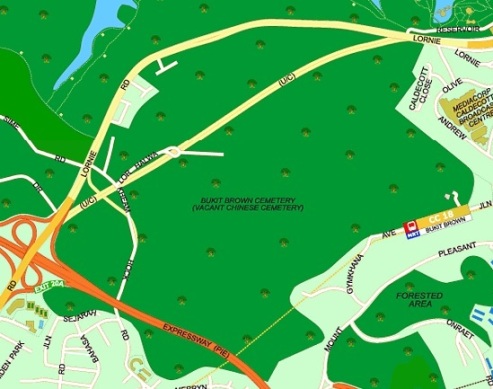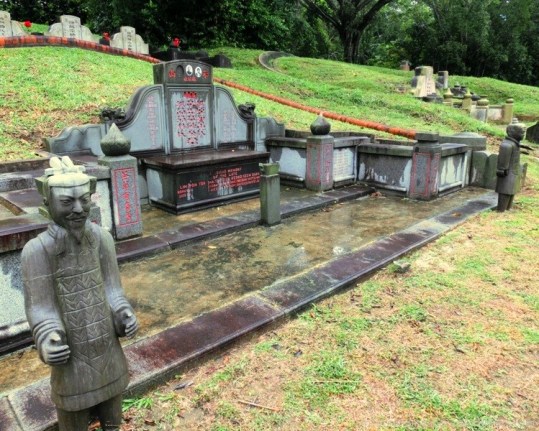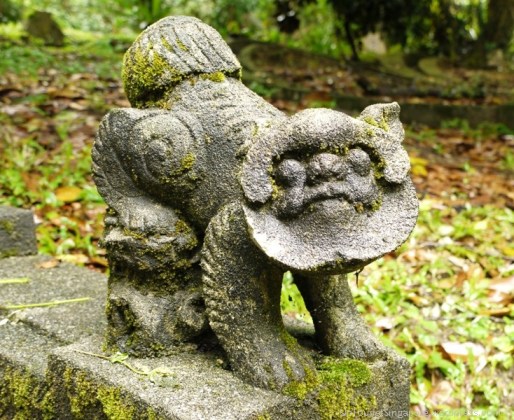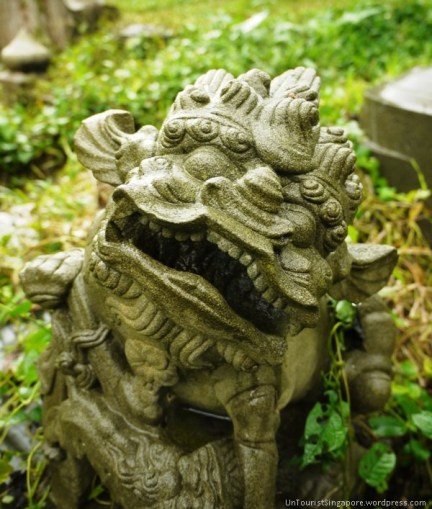And if only they could talk, for what tales they would tell.
Buried in the hills of Bukit Brown are some of early Singapore’s illustrious founding fathers and other notable members of society from the early 1900s. Some of their names would ring a bell, as although these prominent men and women have carried their storied lives to their graves, many live on in the eponymously named streets of Singapore.
Sadly though, not enough people in Singapore know about, let alone care about the aging and in many places overgrown Bukit Brown. Most would be vaguely aware that it is some old cemetery, slated for redevelopment by the city planners. In a nation of people grown inured to the endless razing of the old to make way for the new however, and where many other old cemeteries have already been exhumed, most recently Bidadari, Bukit Brown would just be another site, well whose time had come.
As cemeteries aren’t generally considered endearing to a superstitious people, I would also wager that most of the populace are actually cheering the new super 8-lane highway that would replace parts of the crooked and congested Lornie Road, never mind that it would also drive a stake right through the heart of Bukit Brown. There’s also of course the future housing estate on that prime land many in Singapore would be eyeing.
What a great pity these sentiments are though, as Bukit Brown is so much more than just an old cemetery. Most people fail to realise the value in this rich heritage site, unaware that it is a precious preservation of Singapore’s past. The cemetery is an archaeological site that offers insights into early Singapore’s culture and sociology, and a museum showcasing tile work and other art designs from a bygone era. In fact, exploring the many interesting graves is almost like entering a time vortex that transports you back to the early 1900s in Singapore.
Bukit Brown is also a lovely park, a tranquil and lush sprawling oasis where giant rain trees tower over the charges resting in their shade. A number of rare bird species have even made their home in the park.
THE LOWDOWN
Bukit Brown, or “kopi sua” as the older Chinese know it, is a large municipal cemetery that operated from 1923-1973. Named after British businessman George Brown who owned the land, the graves of over 100,000 of Singapore’s early immigrants lie in this hilly park of about 83 hectares (213 acres), about a quarter larger than the Botanic Gardens.
Bukit Brown is also remarkably the largest Chinese cemetery outside of China, with some graves dating to as far back as the 1800s from when it was a private cemetery. A number of graves were also relocated to Bukit Brown from other sites. There are large, grand tombs as well as small modest ones, and even illegal squatter tombs of those that died too poor to afford a proper plot. There are well-kept tombs where descendants of the deceased still visit regularly, and there are derelict tombs, some lost to the jungle. Most of the graves however have largely been forgotten by the now 3rd and 4th generation descendants.
Sitting on a sizable plot of land in central Singapore, the cemetery has long been earmarked for redevelopment to put the land to more productive use. When plans for the redevelopment of Bukit Brown were announced in 2011, various community groups swung into action in a race against time to not only campaign to “Save Bukit Brown”, but to also uncover the graves and trace the roots of those buried and lost in the cemetery. The groups work alongside the official Bukit Brown Documentation Project by a government team documenting the graves as well as the rituals and other social and cultural practices of the time.
In October this year Bukit Brown also made it to the World Monuments Fund’s 2014 Watch, a list of cultural heritage sites around the globe that are “at risk from the forces of nature and the impact of social, political, and economic change”. What impact this will have on the fate of Bukit Brown remains to be seen, however I can’t remember any incident where the government has made a U-turn on a decision even with pressure from an international community.

Streetdirectory.com showing Bukit Brown as a “Vacant Chinese Cemetery”, and the highway as “U/C” (under construction)
Although the first phase of redevelopment currently sees a little under 5,000 graves being exhumed to make way for the highway, all of Bukit Brown’s residents will eventually be evicted when the area is developed into a housing estate. To date, only about a third of the graves to be exhumed have been claimed. Remains from the unclaimed graves will be cremated and the ashes scattered at sea should they still remain unclaimed for a further 3 years.
Interestingly a local map already lists Bukit Brown as a “Vacant Chinese Cemetery”, recently updated from it being labelled an “Abandoned Chinese Cemetery”. Mass Rapid Transit (MRT) maps also already include the future “Bukit Brown Station” which will ostensibly serve the tens of thousands of new (living) residents.
All in all it does look pretty unlikely that Bukit Brown will be the final resting place for the early pioneering settlers of Singapore.
VISITING
There are 5 hills in the cemetery. If it’s your first time to the cemetery be sure to sign up for one of the free tours conducted by the All Things Bukit Brown volunteer group. The 2 and a half hour tours are held every weekend, sometimes both in the mornings and evenings. Each tour focuses on different areas of the cemetery or on different themes, such as a recent one that visited the graves of women who lived in the 1800s to early 1900s.
The tours are led by enthusiastic and knowledgeable “brownie” guides who all obviously care deeply about the fate of the cemetery. The guides will not only show you some of the more interesting graves off of the main road but will also regale you with tales of the pioneers’ lives. Going on the tour is also a crash course in Feng Shui, art history, culture and religion. Almost all the tombs are planned according to Feng Shui principles and are replete with religious symbolism, many adorned with deities to protect the deceased in their afterlife. Beautiful works of art also attest to how important it was for one’s grave to look good.
Tours are conducted mostly in English although there are Chinese language tours occasionally. Check the group’s Facebook page here. To go on a tour you’ll need to join the group on Facebook by sending a note to the administrator, and once accepted you’ll be able to sign up for the events.
On my first visit to Bukit Brown on a tour, a group of about 30-40 of us were led through 2 of the 5 hills. On a subsequent visit with a friend we strolled from one end of the park to the other through all 5 hills. That drizzly early Saturday morning we saw hardly anyone along the way save for a few riders on horseback from the adjoining National Equestrian Centre, a lone jogger, and one or two expat couples letting their dogs out for a run.
LOCATION
Lorong Halwa, off Kheam Hock Road
You can enter Kheam Hock Road from either Lornie Road or from Dunearn Road in Bukit Timah.
HOW MUCH TIME
At least 2 and a half to 3 hours if you want to meander through all the hills, though sticking to the paved roads only.
TIDBITS
- Behind the tombstone is a large oval mound referred to as the “tomb shore” where the body is buried. This area is shaped like a womb as the Chinese believe that when you die you return to the womb of the earth.
- According to Feng Shui principles the graves ideally faced a north-south direction and be on a hill. The hills of Bukit Brown offered some of the choicest spots for the graves, as the Chinese believed it was important to live well but more important to die well. Death after all was for eternity.
- The 2014 Watch List of the World Monuments Fund has 67 sites from 41 countries and territories.
TAKE NOTE
- It is mosquitoes galore there. The 2 times I visited I came back with over 10 angry red swellings on my exposed arms. Best to wear long pants and long sleeves to keep the mozzies at bay, or else apply mosquito repellent religiously.
- Watch out for ants making their way into your socks and up your pant legs as well.
- Remember your hat and sunscreen if it’s sunny, and an umbrella if it looks likely to rain – there are no shelters in the park.
- There are no toilets. You can visit the loo beforehand at one of the service stations along Adam Road or Dunearn Road.
- There are apparently cobras as well so watch out if you are going off the paved tracks into the bushes.
- Wear appropriate shoes too as some of the mossy bits on the tombs are slippery especially when damp.
USEFUL LINKS
- All Things Bukit Brown
- Bukit Brown Cemetery: Our Roots, Our Future
- The Bukit Brown Cemetery Documentation Project
- World Monuments Fund – Bukit Brown on 2014 Watch
- Paths of History – Bukit Brown (blog post translating a Chinese media article)
- Give Bukit Brown a Chance – short video
INTERLUDE
By Charles Goh
A cool chill blew across the rolling grass of Bukit Brown.
It woke up Tan Kim Ching (son of Tan Tock Seng).
He yelled out to his friend below, Cheang Hong Lim (Speaker’s Corner): You feel that, Hong Lim?”
Hong Lim shuddered and nodded: “Let’s go find out what’s happening.”
Together they strolled down the lonely path till they came up to 2 brothers Lim Chong Pang (Chong Pang Market) and Lim Chong Kuo, with their mother, Mrs Lim Nee Soon (Yishun Estate).
Mrs Lim looked at the 2 elderly gentlemen strolling towards them and asked: “Is it time?”
No one had the answer, and the group decided to cross the valley and ask others.
Gan Eng Seng (Gan Eng Seng School) came down from his hill and met them. They were joined midway by Tan Kheam Hock (Kheam Hock Road). The group, now slightly larger than when it started, visited Chew Boon Lay (Boon Lay MRT), who was chatting with Tan Eng Neo (Eng Neo Avenue).
Together they climbed the hill to Ong Sam Leong (Biggest Grave in Singapore), who was with his sons Boon Tat (Boon Tat Street) and Peng Hock (Joint owner of New World Amusement Park).
From that highest point in Bukit Brown, Boon Lay shouted across the hills to Teh Ho Swee (Bukit Ho Swee), who was with his family, a distance away.
“Do you know what’s happening?” Boon Lay yelled.
“I don’t know.” Ho Swee shouted back, dropping whatever he was doing and running to join the group. “Could it be related to the Bukit Brown MRT being constructed behind me?”.
The wind blew stronger as if to answer him, and the group moved down the hill.
Around the bend, they were joined by Tan Boo Liat (Great Grandson of Tan Tock Seng), Hu Shien Nien (OCBC Director), Tan Ean Kiam (OCBC Founder), Khoo Yang Thin (Father of Khoo Teck Puat [Hospital]).
The group, now considerably larger, swelling in size as other Notables and their families joined the march towards the Bukit Brown Cemetery Gate.
“Can’t you do anything, dad?” asked Lee Choo Neo (aunt of MM Lee) to her dad Lee Hoon Leong (MM Lee’s Grandfather).
Hoon Leong breathed deeply to speak: “I…. I” but his words were interrupted by the arrival of Fang Shan (oldest tomb in Singapore), Ho Siak Kuan (Assistant Secretary for Chinese Affairs), Tan Yong Thian (Southeast Asia 1st Producer of Essential Oil) and Tay Koh Yat (popular public bus operator in the 60s).
“Wait up!” came a voice from behind, as Chew Joo Chiat (Joo Chiat Place) came running from behind and joined the group.
By now, a great multitude of the early Singaporeans had gathered at the Gate. Those who travelled far to reach our shores and made their fortunes and names here, as well as the more common folks, who though you may never, ever know them, had equally shed their sweat, blood, strength, age and lives for our small island in the sun.
Now nearing the Gate, Ang Seah Im (Seah Im Food Center) stopped the group and hushed everyone.
“Can you hear that?”
There are distinct sounds of machinery in the air, rumbling of metal crawlers across cart tracks.
‘Is this the end?” Someone wailed from behind.
“But our stories are not told yet!”
“We once lived! Please don’t! Remember us please!”
The wind howled louder…………













It should be reserved as a cemetery Park and Publc history park! without the respect of your founders
And sense of beauty of these graves and the beauty of your ancestors resting place singapore will lose its
Soul and connection to the past. It should be a world heritage place.
don’t be a caterpillar, eating away everything , which belongs to the community!
Best recommendation-yours Ellen Oki
Hi Ellen,
Yes Bukit Brown Cemetery is important and beautiful in its own way, and it would definitely be a pity to lose it. Singapore is small though so I also see the city planners’ dilemma in how to prioritize competing claims for land use. The cemetery is underutilized as it is, with most of the graves abandoned, and there are taboos in Chinese culture still about visiting cemeteries so you won’t see local families having picnics there or anything. So I don’t know, I will just enjoy the place while I can, and encourage as many people to visit it while it exists.
Thanks for commenting!
MBev
Pingback: Bidadari Park (and Future Housing Estate): Burying the Past | UnTourist Singapore
Howdy! Would you mind if I share your blog with my facebook group?
There’s a lot of people that I think would really enjoy your content.
Please let me know. Cheers
Howdy back, and happy for you to share my blog with your FB friends! If you haven’t visited Bukit Brown yet, please do too.
MBev
Hello! Always learn something new when I read an article on Bukit Brown. Love the place for the history of our pioneers, the greenery and all the little trails. By the way, do you still remember where you took the photo of the tiles with the pigs? The tiles on a lot of the tombs are so beautiful and unique.
Thank you!